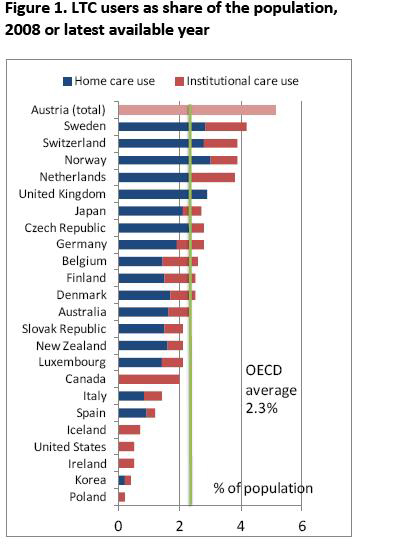The Time Bomb No One Is Talking About
While the United States spends much more per capita on health care than other high-income countries, the share of Americans receiving long-term care is quite low compared to many other countries. OECD projections also suggest that U.S. spending on long-term care as a share of GDP will stay below the OECD average in coming decades.
Because the number of Americans receiving long-term care is so low, U.S. spending on long-term care–whether per capita or as a share of GDP–is well below that of other OECD countries. For example, U.S. spending per capita on long-term care was $455 in 2008, while the OECD average was $543 per capita, and per capita spending on long-term care is upwards of $1200 in Norway, Sweden, and Netherlands. Over time, according to the OECD: “In 2008, public LTC expenditure accounted for 1.2% of GDP, while private LTC expenditure for another 0.3%, on average across the OECD.



It is interesting how the United States spends far less than other countries on Long Term Care (LTC). If Medicare included a LTC benefit back when it was created in 1965, I suspect the total would be far higher today. Currently, Medicaid pays for about two-thirds of LTC in America. I doubt if the need is greater in other countries. But the sense of entitlement is undoubtedly greater. It may also have to do with housing conditions. Living space is far smaller in Europe than in the U.S. Thus, may families would not have the room to care for an aging parent in their own home.
The critics are always telling us we spend more than everybody else on health care. Why don’t they praise us when we spend less that everyobody else on long term care.
Ditto Bruce.
Even with lower than average spending, LTC is going to be a huge problem for us in the future. It’s one thing to say that demographics are shifting. It’s another to deal with the logistics of actually taking care of millions of aging seniors.
At present, I’m not sure that building more senior housing is a good solution to the problem. We’re going to end up returning to the multigenerational housing model. Especially given the financial situation in the United States, we might not have a choice.
OECD data suggest that the US has declining rates of elderly disability unlike most of the OECD countries with ObamaCare analogues. Probably this has something to do with the fact that we spend a lot on health care. So, thanks to ObamaCare, LTC is likely to get a lot more expensive.
I agree that this is a ticking time bomb. It’s going to be a huge problem in the future.
Two observations:
First: The CLASS LTC entitlement in Obamacare will likely bring about the increased spending ancitipated by Devon Herrick and Linda Gorman.
Second: I have seen analyses of U.S. health spending compared to other countries that adjust for military health care, highway accidents, gunshot wounds, logarithmic difference in GDP, and differences in actual spending adjusted for purchasing power parity (PPP).
All result in the conclusion that U.S. health spending is not as out of control as often thought when we just look at health spending/GDP. I wonder what would happen if we looked just at acute health spending, and excluded LTC spending. I expect the U.S. would not look so out of the ordinary in such an analysis either.